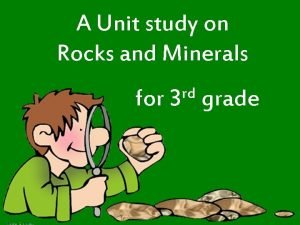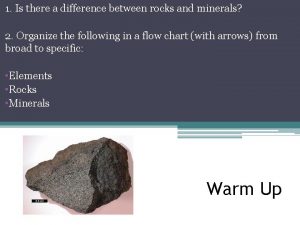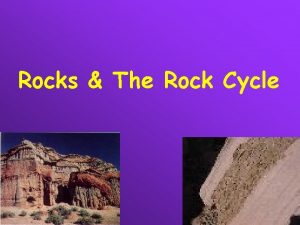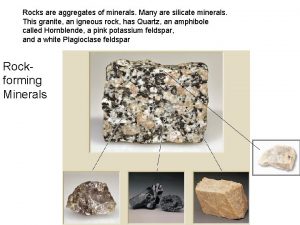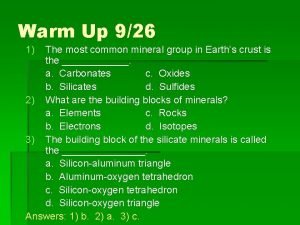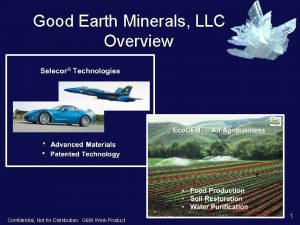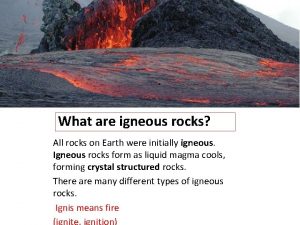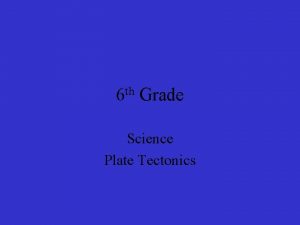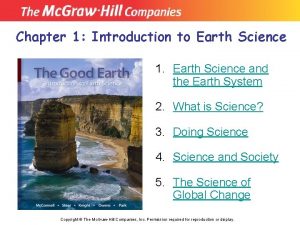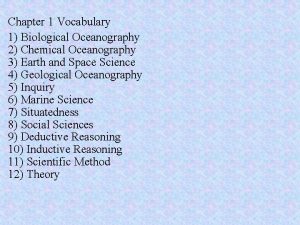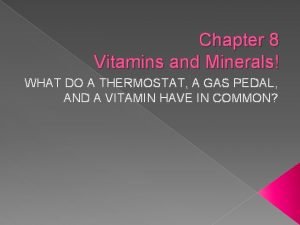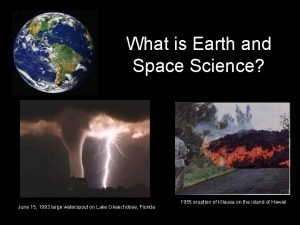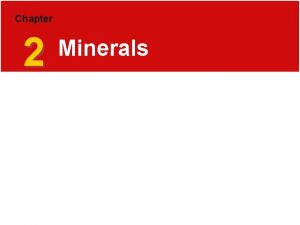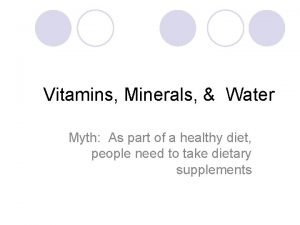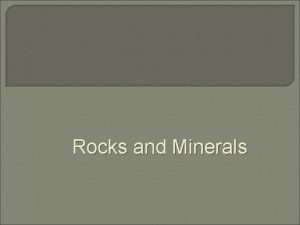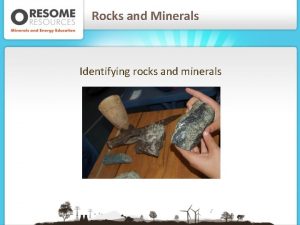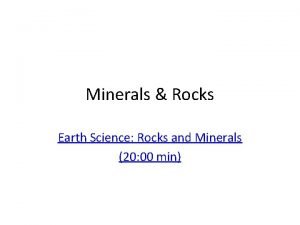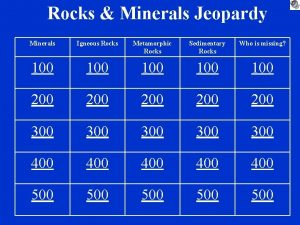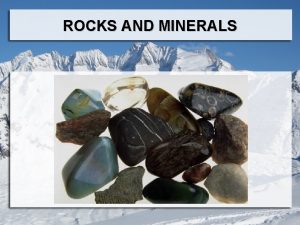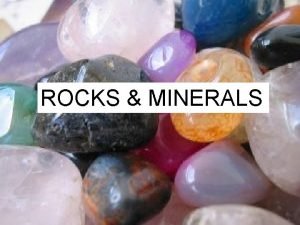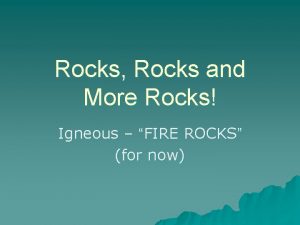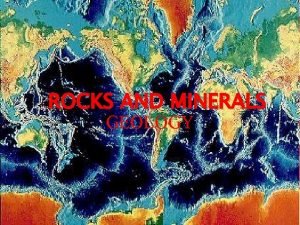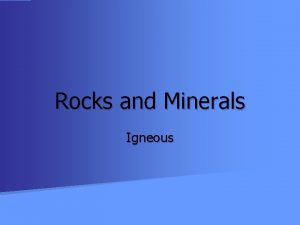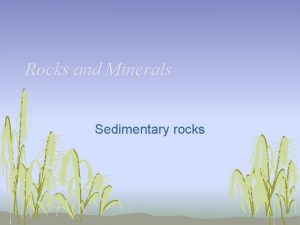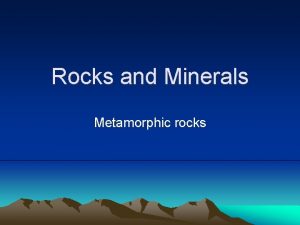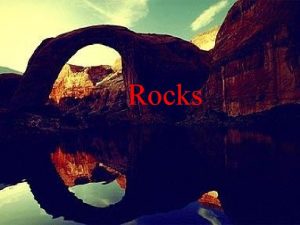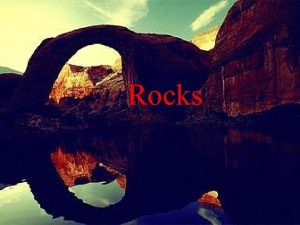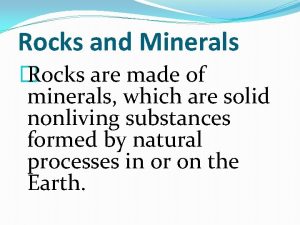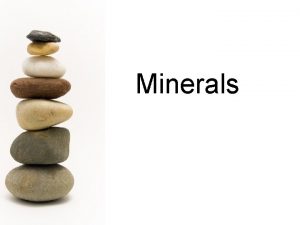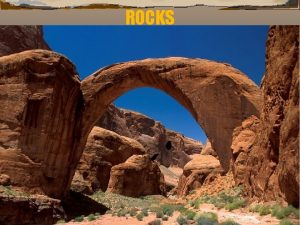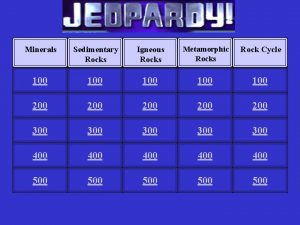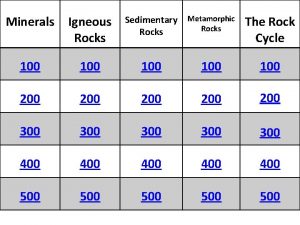Earth Science Chapter 3 Minerals and Rocks Minerals





























- Slides: 29

Earth Science Chapter 3 Minerals and Rocks

Minerals • A mineral is a naturally occurring, solid, inorganic substance that has a definite chemical composition and molecular structure. – Naturally occurring means not made artificially – Inorganic means it is not now, nor ever has been alive. • Minerals are classified on the basis of their physical and chemical properties.

Mineral Characteristics • The physical properties of a mineral are due largely to the internal arrangement of atoms. • The six key physical properties that can be seen or easily tested are: color, streak, luster, hardness, and cleavage or fracture.

Mineral Characteristics • Color – Most visible property – Color alone is not a good mineral identifier. • Many minerals exhibit the same color. • Many minerals are found in a variety of colors.

Mineral Characteristics • Streak – The color of a mineral in its powdered form. – Streak is reliable for mineral identification. • Streak may be different from mineral color.

Mineral Characteristics • Luster – The way in which light is reflected from the surface of a mineral. – Minerals with metallic luster shine like polished metals. – Minerals with nonmetallic luster have no metallic shine. • Nonmetallic lusters can be glassy, dull, earthy, etc.

Mineral Characteristics • Metallic lusters • Nonmetallic lusters

Mineral Characteristics • Hardness – A mineral’s resistance to being scratched – The relative hardness of a mineral is determined by comparing it to the hardness of ten “standard” minerals that make up Moh’s Hardness Scale. – Minerals are often compared to the hardness of glass (5. 5).

Mineral Characteristics • Cleavage – The tendency of a mineral to split along one or more smooth surfaces or planes. Mica (1 plane) Halite (3 planes)

Mineral Characteristics • Fracture – Minerals that don’t show cleavage, fracture unevenly when they break.

Mineral Characteristics • Other properties Magnetic Salty Taste React with Acid Bad Odor

Formation of Minerals • All minerals are crystalline, or made up of atoms arranged in a pattern. • Minerals are grouped according to their chemical composition. – All minerals are made up of elements. – Minerals are classified based upon the elements they contain. – Most common minerals in the crust are silicates (made of silicon and oxygen).

Formation of Minerals – Of all the minerals on the Earth’s crust, over 90% are a combination of the following eight elements: Percent By Mass in Crust

Rocks • Most rocks are composed of one or more minerals. – Rocks composed of one mineral are called monominerallic. – Rocks composed of more than one mineral are called polyminerallic. • Most rocks have a number of minerals in common. – Of the over 2, 500 different minerals, only 10 to 15 minerals compose 90% of rocks.

Rocks • Differences between rocks and minerals – Minerals have a uniform composition while the physical properties of rocks vary from one rock to the next. – Minerals are classified by physical properties while rocks are classified by their origin. • Igneous - solidification of molten rock • Sedimentary - compaction and cementation of sediments • Metamorphic - recrystalization of rock

Igneous Rocks • Igneous rocks form as a result of the solidification of molten rock material. – Molten rock beneath the Earth’s surface is called magma. – Molten rock that reaches the Earth’s surface is called lava. • When molten rock solidifies, it crystallizes into igneous rock.

Igneous Rocks • The texture, or grain appearance, depends on the size and arrangement of crystals. – Intrusive igneous rocks: • Form from magma underground • Solidify slow & have large crystals – Extrusive igneous rocks: • Form from lava above ground • Solidify quick & have small crystals

Igneous Rocks • Igneous rocks are grouped according to their mineral composition. – Felsic igneous rocks • Light color • Low density • Most common on continents – Mafic igneous rocks • Dark color • High density • Most common on ocean floor

Sedimentary Rocks • Sedimentary rocks form as a result of compaction and cementation of sediments. – Sediments are changed into rock after they are transported and deposited. – Most sedimentary rocks are deposited in large bodies of water. – The presence of sedimentary rocks suggests area was underwater at time of formation.

Sedimentary Rocks • Compaction – Pressure created by water and overlying sediments can force particles of sediment close together and compress them into rock. • Cementation – The addition of minerals, such as silica, lime, or iron oxide, tends to glue rock particles together to form solid rock.

Sedimentary Rocks • Clastic Sedimentary Rock – Formed from sediments made up of rock fragments held together by cement – Layers or cementing material are often visible

Sedimentary Rocks • Chemical or Crystalline Sedimentary Rocks – Form as a result of chemical processes • Water with dissolved minerals evaporates • Minerals that precipitate out forms crystals Rock Salt Rock Gypsum

Sedimentary Rocks • Bioclastic or Organic Sedimentary Rocks – Form from remains of dead organisms. • Coal forms as a result of compression of plant remains. • Limestone can be made of shells. Coal Limestone

Metamorphic Rocks • Metamorphic rocks form as a result of recrystallization of unmelted material under conditions of high temperature and pressure over long periods of time. – Recrystallization is a process in which rocks undergo change without true melting. – As a result of heat and pressure minerals in the rocks combine to form new, larger, denser crystalline structures.

Metamorphic Rocks • Banding and foliation of minerals are the most outstanding characteristic of metamorphic rocks. – Due to concentrations of various minerals into zones of different colors – Not to be confused with layering of sedimentary rocks

Metamorphic Rocks • Types of Metamorphism – Contact metamorphism • Molten rock comes in contact with nearby rock • Heat from magma alters the rock it touches – Regional metamorphism • Large areas of rock are under intense heat and pressure • Generally associated with mountain building

The Rock Cycle • The rock cycle describes how rocks of all types can be changed into other rocks. – Earliest rocks formed on Earth were igneous – They were uplifted, weathered, and eroded to form sediments. – The sediments were deposited, buried and compacted into sedimentary rocks. – Sedimentary and igneous rocks were subject to heat and pressure to form metamorphic rocks.

Mineral Conservation • Today the world’s need for energy resources is greater than ever. – Most energy sources-coal, oil, and natural gas -are nonrenewable (used faster than they can be replaced). – Coal oil and natural gas are called fossil fuels because they are made of the remains of plants and animals that lived long ago. – Fossil fuels and other nonrenewable resources are vital to our everyday lives.

Mineral Conservation – Alternate sources of renewable energy resources are under development. • Water power • Wind power • Solar energy • Geothermal energy – The use and distribution of mineral resources have global, financial and political implications. – THEY MUST BE USED WISELY.
 Sedimentary rock song
Sedimentary rock song Compaction and cementation
Compaction and cementation Song about igneous rocks
Song about igneous rocks Difference between rocks and minerals
Difference between rocks and minerals Difference between minerals and rocks
Difference between minerals and rocks Concept map of rock types
Concept map of rock types Suzanna socked me sunday poem
Suzanna socked me sunday poem Whats the difference between rocks and minerals
Whats the difference between rocks and minerals Rock type
Rock type Extrusive igneous rocks
Extrusive igneous rocks Volcanic rocks and plutonic rocks
Volcanic rocks and plutonic rocks Minerals vs elements
Minerals vs elements Rocks are aggregates of minerals
Rocks are aggregates of minerals Most abundant minerals in earth's crust
Most abundant minerals in earth's crust Good earth minerals
Good earth minerals Science science science
Science science science Ignition rocks
Ignition rocks Breaks in earth's crust where rocks slipped past each other
Breaks in earth's crust where rocks slipped past each other Chapter 1 introduction to earth science
Chapter 1 introduction to earth science Earth science chapter 1 vocabulary
Earth science chapter 1 vocabulary Chapter 8 vitamins and minerals
Chapter 8 vitamins and minerals Earth science regents part d
Earth science regents part d Earth definition science
Earth definition science Sedimentary and metamorphic rocks section 6.1
Sedimentary and metamorphic rocks section 6.1 Chapter 2 minerals
Chapter 2 minerals Minerals sources functions and deficiency chart
Minerals sources functions and deficiency chart A pattern of meteorological symbols that represent weather
A pattern of meteorological symbols that represent weather Earth science sol 2010
Earth science sol 2010 Regents earth science lab practical
Regents earth science lab practical Earth science lab practical
Earth science lab practical




